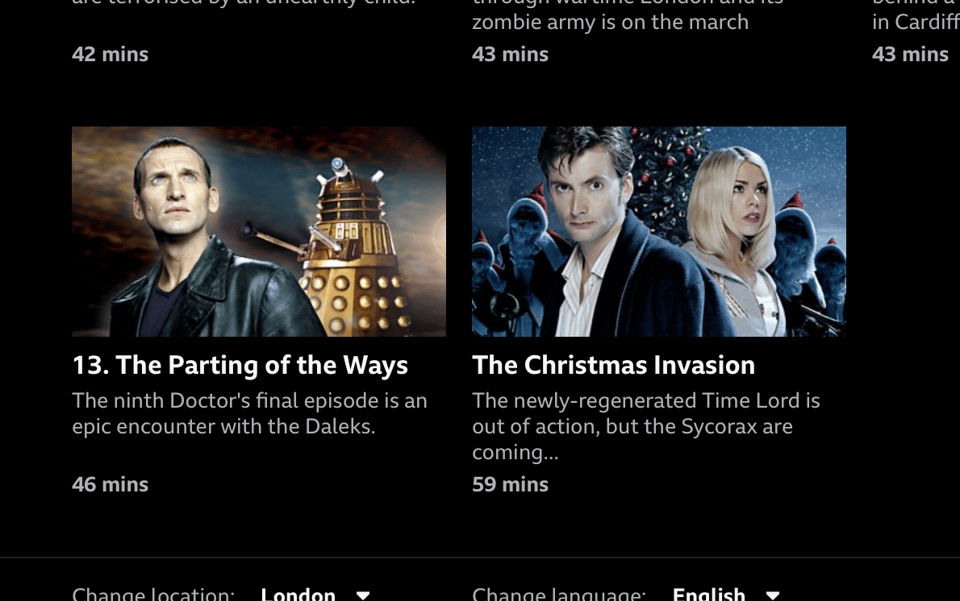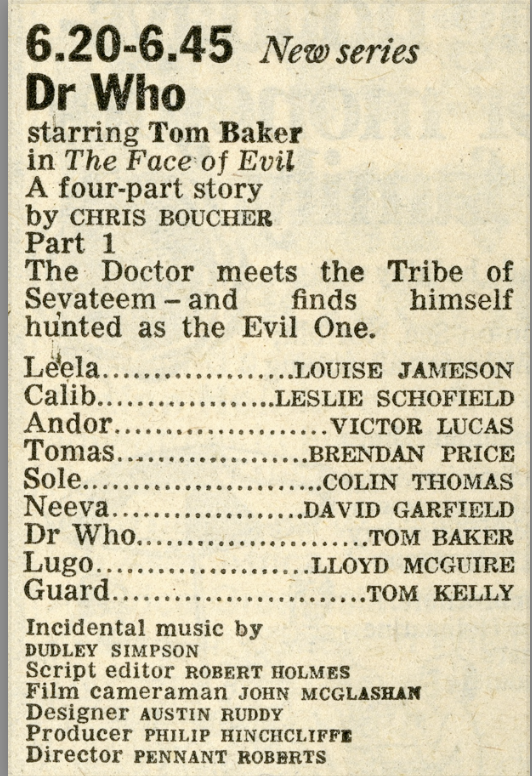Seasons in the Sun
It is a source of joy to me that the fabulous The Church on Ruby Road is a Doctor Who special transmitted in 2023 and yet it is not, according to wikipedia and the Blu-ray release, part of the entity known as "Doctor Who 2023 Specials". BBC iplayer initially hedged its bets on the question, adopting a constructive ambiguity that was resolved when the series returned in May.
Well, I say “resolved”. Having previously sat with the three episodes of Doctor Who shown in the same year, Ruby Road was in May moved to the “Season 1” section of Doctor Who, making it a Special, but not part of the section labelled “Specials”. But hold on, “Season 1”? This isn’t the first series of Doctor Who. It’s not even the first series of Doctor Who this decade, let alone this century. There’s an argument that The Church on Ruby Road, if it’s not part of the “Specials” is not even in the first series of Doctor Who transmitted in 2023.
This is, after all, the same entity that wikipedia calls “Series 14”, although the scheduled blu-ray release concurs with iplayer. But then the iplayer, currently home to all extant transmitted Doctor Who breaks Doctor Who up into three distinct series Doctor Who (1963-1996), which is divided up into “Seasons”, Doctor Who (2005-2022) which is divided up into “Series” and Doctor Who (no qualifications) which starts with The Star Beast.

Or at least it does now, until very recently the third of those was Doctor Who (2023 - ) and the second was Doctor Who (no qualifications). Presumably until someone noticed that made the post twentieth century, pre-Disney stuff the definitive article at the expense of the current iteration.
No matter quite how they’re labelled, those divisions seem odd to me, a child of the twentieth century. The 1996 TVM, whatever one thinks of its quality, will never be part of the 1963-89 series for me, because I remember waiting more than a third of my then lifetime for it after Survival. Despite Sylvester McCoy’s presence the idea that it’s part of the old show will never stick. It’s either a distinct entity between the 1963-89 and 2005 onwards series, or all three, now apparently four, are part of one continuous, yet broken, whole.
Equally, but also opposite, the idea that The Power of the Doctor (2022) is not part of the same programme as The Star Beast (2023) when one cliffhangers into the other and they were transmitted slightly more than a year a part is less odd, but still odd. On an instinctual level, at least. I understand why you’d want to separate them in terms of marketing, and there may very well be agreements with Disney of which I’m not aware that demand it.
When 21st century Doctor Who began, the organisation of the show's new run seemed pretty straightforward. We were told that the programme was renumbering. Which made sense, it was a kind of new volume, and the term “Series” which was more common in UK television was applied rather than “Season”, which was usually used for the old show, but which had largely been applied ex post facto by its fandom. (Of which more later.)
“Series One” roared out the blocks in Spring and Summer 2005 and was issued on DVD before the end of the year. But the staggering success of this new run meant that the Doctor Who’s first proper Christmas special was commissioned in March, made in the summer and transmitted on Christmas Day. Christmas Day of the same year.
A combination of the change of Doctor (from Christopher Eccleston to David Tennant) and it being the first story of a new production block made it seem natural to include the last episode of the space year 2005, The Christmas Invasion, with the 2006 series, and the desire to get the aforementioned DVD box set out for Christmas 2005 with a bonus feature looking forward to that special probably helped. That set a precedent for the rest of the RTD era, with each series defined box set including a Christmas special shown months earlier and in a different year.
It's that logic that, it seems, The Church on Ruby Road is following, although it's a logic that partially broke down as long ago as 2009. The "2009 Specials" are five long episodes, only three of which were transmitted in 2009. The first of which was made at the end of the production block that had begun with the 2007 Christmas special, Voyage of the Damned. All five episodes had production codes indicating they were part of Series 4. This is where the iplayer groups them. (Although IMDB steadfastly refuses to.)
For (again) sound commercial reasons, the 2009 (ish) stories also had a DVD release that was separate from that of Series 4 itself. The soundtrack release hedges its bets and calls them "The Series 4 Specials", while Wikipedia eventually folded and started calling them "The 2008-2010 Specials". Although that creates the additional problem that A Christmas Carol, a Doctor Who special shown in 2010 is not one of them. It's part of Series 5. Well, when on iplayer. It's also part of Series 6. When on Blu-ray. The Doctor, the Widow and the Wardrobe, the Christmas special actually made at the end of Series 6 is part of Series 7. On Blu-ray. A set that contains Christmas specials shown in three different calendar years. As a long era of gap years and split seasons got underway, ambiguity as to which series a seasonal special was shown nearest or made as part of became increasingly arguable, increasingly obscure.
After this point, I could not tell you with absolute certainty, without physically checking the boxes and discs on the shelves, which Series certain specials are part of. Sure, I could check the iplayer on my phone, but they're so rarely in agreement.The iplayer even, like the early Character Options figures packaging, makes The Christmas Invasion part of “Series 1”.

There is similar, ambiguity over how we arrange the older show. Sorry, the older older show. Or rather there should be. But we are, seemingly, all long agreed that there are twenty six “seasons” of twentieth century Doctor Who. That was certainly the consensus before the old show ended in 1989, and it’s the consensus now. Sufficiently so that there’s not been so much of a whiff of disagreement with the Blu-ray “collection” of the series being arranged in twenty six sets. Everyone knows what will be in each set, even though they’re coming out in a numerically random order.
When though, did this consensus emerge? Is it just because a series that ran for 26 years, one week and six days having 26 seasons instinctively make sense? Well, not quite. If you look at the much hallowed Radio Times 10th Anniversary Special, that organises the Doctor Who transmitted up to that point in terms of calender years, with the terms "series" and "season" nowhere to be seen. But by the end of the show's 1980s run, producer John Nathan-Turner was himself using the term "Season 24" to describe the programmes he was making for 1987. What happened in-between?
Dr Martin Wiggins, once of the DWAS, now of the Shakespeare Institute, Stratford remembers coining the term “the fourteenth season” for the fan magazine Tardis ‘77 to describe the then current run, and indicates that this was the point where fans started to shuffle their series past into discrete, manageable chunks. Perhaps in imitation of Star Trek, Trekkies/ers being arguably the Ur-television fandom, responsible for a lot of the argot used by many tv fandoms (fanda?) to this day.
Some “seasons” do seem obviously, even inarguably “real”. The Doctor Who series shown in 1970, 1971, 1982 and 1984 - 1987 and 1989 fall neatly into “seasons”, a production block of episodes transmitted in a more or less continuous run, and inside a single calendar year. If we throw in transmission runs that sneaked into the calendar year before or after the one in which most of their episodes were shown by a fortnight or so, we can add 1988 and perhaps 1972-74 (of which more shortly).
That's 12 "seasons" almost half the show. So what am I on about? Let's look at some of those more liminal cases. We can't include 1983 in the above list, because of The Five Doctors, made separately and between the 1983 and 1984 series. It was transmitted closer to the latter than the former, but its status as the 20th anniversary special means it's usually included with the former. Including on the recent Blu-ray release. Not least because the cancellation of that season's finale, a Dalek story finally made the following year, means "Season 20" is short without it, and adding it to "Season 21" makes that run overlong.
Yet back in 1984, Doctor Who Magazine was very certain that the "Special" as it was then referred to, was part of neither series. Which is technically true in terms of budget, production and transmission. History, and fan and BBC practice, has decided otherwise.
Those seasons, even 1983, are the easy ones. Broadly continuous production blocks and transmission runs, shown broadly within a calendar year. (Although the first two Davison series had a production gap between their second and third stories to allow Davison to make a different programme entirely; BBC One sitcom Sink or Swim.) Elsewhere it's much less easy to defend the status quo.
Although the 1976/77 series of Doctor Who was a more or less continuous production, the show took more than a month off transmission over Christmas. The Deadly Assassin finished on 20th November and The Face of Evil didn't start until 3rd January 1977. There's an argument that a transmission gap that big, four whole Saturdays without Doctor Who, combined with the turn of the year, means that the second half of what we call "Season 14" is really another series entirely. An early 1977 one. What's more, the Radio Times for the start of the first of those stories agrees.

The last series of 20th century Doctor Who to take a Christmas break was the 1980/81 series, "Season 18" in fan terms, which skipped two Saturdays between State of Decay and Warriors' Gate. (Neither the 78/79 or 79/80 series bothered with a skip month.) But again some listings referred to the new serial starting in the new year as being the first of a "new series". There's an argument we should be talking about at least three more Tom Baker "seasons" over the same period of time, if we're breaking up by transmission run.
The last Baker season offers another oddity in posterity. K9 and Company: A Girl's Best Friend is not an episode of Doctor Who, but it was made as part of, indeed right at the end of Season 19. In a reverse of the usual Christmas special logic it's included on the Season 18 Blu-ray. Orphaned away from the season it was made with and transmitted nearest. Presumably because fan audiences understandably relate Sarah Jane Smith and K9 more to the Tom Baker Doctor than to Davison's.
You might have noticed I said "Four whole Saturdays without Doctor Who" above when there are actually five Saturdays in that interstitial gap over yuletide 19976. That's because 27th of November 1976 was devoted to an early evening omnibus repeat of Pyramids of Mars. A similar thing happened almost exactly a year later when (what we call) Season 15 took the last two weeks of December and the first week of January off between The Sun Makers and Underworld. Two of those weeks were filled in with double length compilation repeat episodes of The Robots of Death. This, you may think, is irrelevant to the argument. Repeat weeks, unusual in UK television in the 1970s, although common in all eras of US network TV, don't either constitute a season break or extend a season over one. You're probably right, but we'll come back to repeats later.
At the other end of Tom Baker's time, we find a curiously similar problem. In very early 1975 The Ark in Space Part Two was seen by 13.6m viewers. Not only was this Doctor Who’s largest audience for ten years, it also propelled the series to fifth place in the national television chart. The highest placing it ever achieved in the 20th century.
This ratings success led to, in effect, the season then in production being extended, resulting in two Doctor Who transmission series in 1975. The one that had started in the final week of 1974 and ran until Spring, and another that began in the Autumn. These are the runs of episodes that fan history calls “Season 12” and “Season 13”, but they were a single long production block with a large transmission break; three weeks passed between the final studio for Genesis of the Daleks (the last produced story for "Season 12" and the first location date for Terror of the Zygons, the first story of "Season 13".
This is not, as you might be thinking, because Zygons was originally planned as the final story of "Season 12" (although it was). There was even less time, not quite a week, between the completion of Terror of the Zygons and the first filming date for Pyramids of Mars. After this Tom Baker and Elisabeth Sladen continued to work on the series without signifiant pause until they completed The Seeds of Doom just before Christmas 1976, having gone out to location for The Sontaran Experiment over a year earlier in September 1975.
The holding back of Terror of the Zygons until September resulted in the early 1975 series only consisting of twenty episodes, easily the shortest transmitted run of Doctor Who then to date. Despite most of them being made as part of a continuous production block of 42. This was the longest since the 1960s, and with the bulk of both "Season 12" and "Season 13" transmitting in 1975, the year as a whole, though, contained 35 episodes. The most since 1968.
This double commissioning, possible in an era of multi-camera videotape production in a large, permanent, multi-purpose studio complex, was not uncommon in the BBC of the time. Series that were perceived as doing well were rewarded with a second series within a year. There are two 1969 series of Dad’s Army, two 1984 series of Ever Decreasing Circles, and so on. This, though, was the only time it happened to Doctor Who, at least in the 20th century.(It’s arguable that the rush commissioning of The Christmas Invasion constitutes exactly that this century.)
In the 1960s Doctor Who was, in practice, on all year, with a few weeks break in the summer. But this break never once coincided with the end of a production season / block, with in each instance at least one serial being held over so the harassed production team had episodes “in hand” for when they began transmitting again. There are several occasions where the fan mandated stops and starts of "seasons" seem almost arbitrary.
The best example is that the 1968 repeat of The Evil of the Daleks (1967) is worked into the fiction of the series (and to the extent that it now has its own novelisation) at the end of The Wheel in Space and that repeat ran up until the start of The Dominators, the first story of what fans call “Season 6”. A story for which the location filming had overlapped with the studio recordings for The Wheel in Space.
How, we might ask, is the gap between The Wheel in Space and The Dominators that between “Season 5” and “Season 6” when there is no gap in either production or transmission terms? It just is. 1970s fans decided that and we go along with it. Even though there's actually a two week transmission gap between the end of The Mind Robber and the start of the next serial The Invasion, with Doctor Who taking the 19th and the 26th of October off. That's a break that accords with both production and transmission, but when deciding what constituted a 1960s season, 1970s fandom decided a repeat didn't count.
My point is, the criteria we've used to decide Doctor Who's "seasons" are if not arbitrary, then certainly inconsistent and inconsistently applied. (Just like those we use for Hartnell era story titles; of which more another time.)
Certainly the fan designated groupings and numbers were rarely used, and certainly not consistently, by the production teams making those programmes. Even in retirement Barry Letts, for example, would almost always use e.g. "the second season" / "series” and / or "Series 2" to mean the 1971 transmission run, his own second in charge.
Later producer John Nathan-Turner, working almost entirely after the fan designations became currency, contentedly use them when “in office”, as I noted above, but he also talked of a putative final McCoy series as “the fourth season” when ruminating on it never happening. You use the terms that make the most sense at the time. Some of them stick, and some of them don't.
A friend of mine, an academic librarian, used to describe her job as "sorting things into logical orders". And that's the point. There is often more than one logical order for any set. That doesn't make either of them wrong, but it also doesn't necessarily make one of them more right. There's nothing (much) wrong with what we've got and we're probably stuck with it. But it wasn't inevitable, and it isn't the only way it might have ended up.
